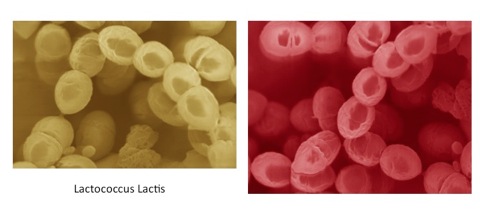1/ The Mucosal Immune System of the pig and the sheep.
Intestinal immune induction following targeting of soluble antigens to aminopeptidase N on enterocytes : nature of antigen, role of enterocytes and of intestinal dendritic cells
FWO Project, 2012-2015, Dr. Annelies Coddens, Promotor Prof. Eric Cox
The dominant response mode of the mucosal immune system is immunological tolerance. This is one of the reasons that very few foreign soluble antigens can induce an intestinal immune response when given orally. In pigs one of this rare antigens are F4ac fimbria of E. coli, which binds to a receptor (APN) on enterocytes whereafter endocytosis and transcytosis occurs. We hypothesize that polymeric antigen is needed for efficient binding to APN, uptake by enterocytes, and transcytosis and that this uptake results in an indirect and/or direct maturation of intestinal DCs which subsequently activate antigen-specific CD4+T-cells leading to
an intestinal immune response, whereas in the absence of this interaction tolerance will occur. Firstly, the interaction of antigen and the APN receptor is studied using polymeric and monomeric F4, and antibodies against APN, and endocytosis and transcytosis will be analysed in APN expressing cells. Secondly the early cytokine signals by the enterocytes and DCs following contact with these different antigens is studied. This study will give further insights in the early events leading to immunity or tolerance following oral administration of soluble antigens.
Publications
Contact : Annelies Coddens, Vesna Melkebeek
Annelies.Coddens @Ugent.be, Vesna.Melkebeek@Ugent.be
Selective targeting of epithelial receptors to modify the dialogue between enterocytes and antigen presenting cells from tolerogenic to immunogenic
PD UGent BOF Grant, 2013-2015, Dr. Bert Devriendt, promotor Eric Cox
The gastro-intestinal lymphoid tissue constitutes the largest immune system in the mammalian body and is the primary route by which the body is exposed to foreign antigens. As such the default response mode of the intestinal immune system to soluble antigens is immunological hyporesponsiveness or oral tolerance. Due to the dominance of these immunosuppressive mechanisms, oral vaccination with soluble antigens is generally ineffective to induce protective immunity, although a few exceptions exist, such as F4 fimbriae purified from enterotoxigenic E. coli. Understanding the mechanisms driving the oral immunogenicity of these rare antigens is pivotal to grasp how intestinal immune responses can be modulated towards tolerance or protective immunity. Our research group previously demonstrated that F4 fimbriae are potent oral immunogens, which can be partly explained by their receptor-mediated transcytosis via enterocytes. Aminopeptidase N (APN) was recently identified as the involved epithelial receptor and we intend to elucidate the function of APN in the intestinal immunogenicity of F4 fimbriae. The current project will deepen our understanding of APN-induced intestinal immunity and will provide insights in how we can modulate the APN-mediated crosstalk between enterocytes and the underlying antigen-presenting cells to obtain the desired immune response in both pig and human, as pigs resemble genetically, physiologically and immunologically human more closely than mice.
Publications
Contact: Bert Devriendt
B.Devriendt@UGent.be
Yeast shells as antigen delivery for oral vaccination in pigs.
IWT SBO PhD Grant, 2011-2015, Kim Baert, Promotor Eric Cox
Introduction
Gastro-intestinal infections remain one of the main causes of morbidity and mortality in both humans and animals. Enterotoxigenic Escherichia coli (ETEC) strains are responsible for travellers’ diarrhea and for the most cases of diarrhea in developing nations. In pigs, ETEC infections are one of the most important causes of diarrhea in neonatal and newly weaned piglets, which result in significant economical losses. The key virulence factor of E. coli are the fimbriae (F). These fimbriae mediate the pathogen for attachment to porcine small intestinal epithelial cells and subsequent colonization. The most prevalent porcine ETEC strains possess F4 fimbriae or F18 fimbriae.
Oral vaccination is the most efficient way to protect these piglets against ETEC infections. New vaccination strategies focus on the implementation of safer recombinant subunit vaccines. However, the oral administration of soluble antigens knows several limitations, such as the passage through the harsh environment of the gastrointestinal tract and the migration through the intestinal epithelia barrier in sufficient amounts before reaching the gut-assosicated lymphoid tissue (GALT). Moreover, soluble antigens generally induce oral tolerance instead of a protective immunity. The encapsulation of ETEC-specific antigens in microparticles delivery systems seems a promising strategy to overcome these limitations as they can protect the antigens against degradation as well as carry potent adjuvants or immune modulators to enhance the immunogenicity. In this project, we evaluate the capacity of yeast particles (YPs) to deliver ETEC-specific antigens to the GALT. The use of yeast particles as antigen delivery system is an innovative and promising method to transport antigens. These antigen-carriers are derived from the cell wall of Saccharomyces cerevisiae (Baker’s yeast) and are composed of >85% β-1,3-D-glucan polymers (β-glucans), ~2% chitin and <1% lipids and proteins, with the rest being mostly ash and moisture. As their wall exist mainly of β-glucans, these particles could serve as both an vaccine delivery system and an adjuvant system.
Aim
The aim of this project is to develop an efficient oral vaccine against F18+ ETEC/VTEC infections to prevent diarrhea in recently weaned piglets. To achieve this, we will encapsulate the FedF tipadhesin in yeast particles and target the particles to aminopeptidase N (APN). This receptor is present on intestinal epithelia cells (IEC) as well as on dendritic cells (DCs), and is co-responsible for transcytosis of F4 fimbriae through enterocytes and M-cells. Therefore, targeting the yeast particles to APN could enhance the migration through the epithelia barrier as well as the endocytosis in immune cells. The engulfment of the particles in immune cells could also be promoted by binding of the β-glucanwall on their specific β-glucanreceptor. In this project, we will focus on this interaction as well, and furthermore, determine the major β-glucanreceptor in porcine innate immune cells.
The advantage of yeast particles in comparisation to traditional particles is their combined function as antigen carrier and adjuvans and their high capacity to load antigens. We will evaluate as first the functional characteristics and immunogenicity of yeast particles in pigs.
Publications
Contact : Kim Baert
ksbaert.baert@ugent.be
Fluorescence activated cell sorter (FACS)
Hercules project, 2008-2013, Promotor Prof. Eric Cox, Co-promotors Prof. B. Goddeeris, H. Favoreel, E. Claerebout
Introduction
This lab equipment is a high performance, flexible, completely digital flow cytometer to analyse and sort cells and particles. It is highly efficient and user friendly.
In immunological research the characterization of individual cell populations is extremely important, not only phenotypically, but also functionally and therefore the isolation of individual cell populations is extremely important. There are several techniques to purify specific immune cells of which cell sorting by FACS is the most efficient leading to the highest purity.
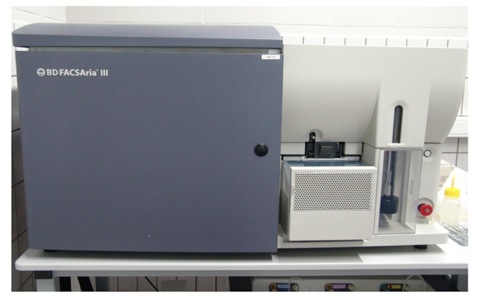
Features
Positive air pressure forces sample cells through an optically gel-coupled cuvette flow cell. Hydrodynamic focusing guides particles in a single-file stream through the cuvette, where laser light intercepts the stream at the sample interrogation point.
After leaving the nozzle, particles pass through the sort block that houses the deflection plates. The novel design fixes the plates in position for more efficient and reproducible deflection into a collection device in the sort collection chamber.
The optics system allows optimizing multicolor assays and panel design for superior results. This design allows choice of laser excitation wavelength(s) that illuminate cells in the sample, and collection optics that direct light scatter and fluorescence signals through spectral filters to detectors. Innovative designs for both the excitation and collection optics reduce excitation losses and dramatically improve collection efficiency, yielding better information from each sample.
The capability of our advanced cell sorter is defined by its flexibility, 11 parameters that can be measured simultaneously. It can support three lasers with following wavelengths : 405,488 and 633 nm.
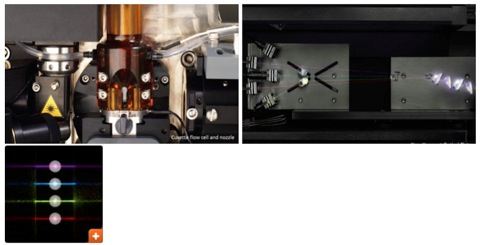
Projects currently running:
-The role of porcine DC subpopulations in the development of immunity or tolerance, and their interactions with different T-cell subsets (Lab of Immunology)
-Interaction between the Herpes viruses and the immune system, especially Natural Killer (NK) cells and plasmacytoid dendritic cells (pDCs) (Lab of Virology)
-The interaction of Giardia duodenalis with porcine DC populations (Lab of Parasitology)
-The role of bovine DCs in the development of immunity against Ostertagia ostertagi (Lab of Parasitology)
-The function of phagocytes at the nasal mucosa during PRRSV infection of piglets (Lab of Virology)
Past projects:
-The role of cell-mediated immunity during coronavirus infections (FIPV) in cats (Lab of Virology)
Publications
-Devriendt B., Baert K., Dierendonck M., Favoreel H., De Koker S., Remon J.P., De Geest B.G, Cox E., 2012. One-step spray-dried polyelectrolyte microparticles enhance the antigen cross-presentation capacity of porcine dendritic cells. Eur. J. Pharm. Biopharm., DOI: 10.1016/j.ejpb.2012.11.016
-Vermeulen B.L.G., Devriendt B., Olyslaegers D.A., Dedeurwaerder A., Desmarets L.M., Favoreel H.W., Dewerchin H.L., Nauwynck H.J., 2012. The role of regulatory lymphocytes during natural infection with feline infectious peritonitis. Vet. Microbiol., 164:46-59.
-Vermeulen B.L.G., Devriendt B., Dedeurwaerder A., Olyslaegers D.A., Desmarets L.M., Grauwet K.L., Favoreel H.W., Dewerchin H.L., Nauwynck H.J., 2012. Natural Killer cells: frequency, phenotype and function in healthy cats. Vet. Immunol. Immunopathol., 150 (1-2):69-78.
-Hoorens P., Rinaldi M., Mihi B., Dreesen L., Grit G., Meeusen E., Li R.W., Geldhof P., 2011. Galectin-11 induction in the gastrointestinal tract of cattle following nematode and protozoan infections. Parasite Immunology 33, 669–678.
Contact: Bert Devriendt
B.Devriendt@UGent.be
Tel: 0032 9 264 73 43
2/ New delivery systems of oral vaccinations in veterinary applications.
Aminopeptidase N, The intestinal receptor for F4+ ETEC as target for oral vaccine delivery.
IOF-Advanced project 2012-2013, Dr. Vesna Melkebeek, Hanne Vereecke, Promotor Prof. Eric Cox
Topics
Whereas attenuated oral vaccines have a risk of residual virulence or reversion of virulence, until now there are no effective inactive oral vaccins on the veterinary market and only a few on the human market. Nevertheless is the oral route the route of choice to induce a protective immunity against enteropathogens. One of the reasons for the lack of inactivated vaccines is that most orally administered soluble antigens induce rather tolerance than immunity. There are a few exceptions, like for example F4 fimbriae purified from enterotoxigenic E. coli. Receptor-mediated uptake of these fimbriae plays a crucial role in their oral immunogenicity. We identified aminopeptidase N (APN)/ CD13 as a receptor involved in transcytosis of F4.
Perspectives
To study the interaction of F4 with APN
To examine the role of APN/ CD13 in the mucosal immunogenicity of F4.
To examine the mechanism of immune induction.
To target APN for induction of antigen/pathogen-specific mucosal antibody responses. In a first phase monoclonals will be developed against APN of the pig which cross-react with human APN. In the second phase, the antibodies will be conjugated with an antigen of an F18+ E. coli strain, responsible for an economical important disease in pigs (weaning diarrhoea and oedema disease), and an immunisation and challenge study will be performed in pigs.
To deliver the proof of concept that targeted oral vaccination is feasible in pigs.
To determine if a similar approach could be possible via the nasal route and in humans.
Publications
Contact : Vesna Melkebeek
Vesna.Melkebeek@Ugent.be
Intestinal immune induction following targeting of soluble antigens to aminopeptidase N on enterocytes : nature of antigen, role of enterocytes and of intestinal dendritic cells
FWO Project, 2012-2015, Dr. Annelies Coddens, Promotor Prof. Eric Cox
The dominant response mode of the mucosal immune system is immunological tolerance. This is one of the reasons that very few foreign soluble antigens can induce an intestinal immune response when given orally. In pigs one of this rare antigens are F4ac fimbria of E. coli, which binds to a receptor (APN) on enterocytes whereafter endocytosis and transcytosis occurs. We hypothesize that polymeric antigen is needed for efficient binding to APN, uptake by enterocytes, and transcytosis and that this uptake results in an indirect and/or direct maturation of intestinal DCs which subsequently activate antigen-specific CD4+T-cells leading to
an intestinal immune response, whereas in the absence of this interaction tolerance will occur. Firstly, the interaction of antigen and the APN receptor is studied using polymeric and monomeric F4, and antibodies against APN, and endocytosis and transcytosis will be analysed in APN expressing cells. Secondly the early cytokine signals by the enterocytes and DCs following contact with these different antigens is studied. This study will give further insights in the early events leading to immunity or tolerance following oral administration of soluble antigens.
Publications
Contact : Annelies Coddens, Vesna Melkebeek
Annelies.Coddens @Ugent.be, Vesna.Melkebeek@Ugent.be
Yeast shells as antigen delivery for oral vaccination in pigs.
IWT SBO PhD Grant, 2011-2015, Kim Baert, Promotor Eric Cox
Introduction
Gastro-intestinal infections remain one of the main causes of morbidity and mortality in both humans and animals. Enterotoxigenic Escherichia coli (ETEC) strains are responsible for travellers’ diarrhea and for the most cases of diarrhea in developing nations. In pigs, ETEC infections are one of the most important causes of diarrhea in neonatal and newly weaned piglets, which result in significant economical losses. The key virulence factor of E. coli are the fimbriae (F). These fimbriae mediate the pathogen for attachment to porcine small intestinal epithelial cells and subsequent colonization. The most prevalent porcine ETEC strains possess F4 fimbriae or F18 fimbriae.
Oral vaccination is the most efficient way to protect these piglets against ETEC infections. New vaccination strategies focus on the implementation of safer recombinant subunit vaccines. However, the oral administration of soluble antigens knows several limitations, such as the passage through the harsh environment of the gastrointestinal tract and the migration through the intestinal epithelia barrier in sufficient amounts before reaching the gut-assosicated lymphoid tissue (GALT). Moreover, soluble antigens generally induce oral tolerance instead of a protective immunity. The encapsulation of ETEC-specific antigens in microparticles delivery systems seems a promising strategy to overcome these limitations as they can protect the antigens against degradation as well as carry potent adjuvants or immune modulators to enhance the immunogenicity. In this project, we evaluate the capacity of yeast particles (YPs) to deliver ETEC-specific antigens to the GALT. The use of yeast particles as antigen delivery system is an innovative and promising method to transport antigens. These antigen-carriers are derived from the cell wall of Saccharomyces cerevisiae (Baker’s yeast) and are composed of >85% β-1,3-D-glucan polymers (β-glucans), ~2% chitin and <1% lipids and proteins, with the rest being mostly ash and moisture. As their wall exist mainly of β-glucans, these particles could serve as both an vaccine delivery system and an adjuvant system.
Aim
The aim of this project is to develop an efficient oral vaccine against F18+ ETEC/VTEC infections to prevent diarrhea in recently weaned piglets. To achieve this, we will encapsulate the FedF tipadhesin in yeast particles and target the particles to aminopeptidase N (APN). This receptor is present on intestinal epithelia cells (IEC) as well as on dendritic cells (DCs), and is co-responsible for transcytosis of F4 fimbriae through enterocytes and M-cells. Therefore, targeting the yeast particles to APN could enhance the migration through the epithelia barrier as well as the endocytosis in immune cells. The engulfment of the particles in immune cells could also be promoted by binding of the β-glucanwall on their specific β-glucanreceptor. In this project, we will focus on this interaction as well, and furthermore, determine the major β-glucanreceptor in porcine innate immune cells.
The advantage of yeast particles in comparisation to traditional particles is their combined function as antigen carrier and adjuvans and their high capacity to load antigens. We will evaluate as first the functional characteristics and immunogenicity of yeast particles in pigs.
Publications
Contact : Kim Baert
ksbaert.Baert@ugent.be
Using Lactococcus lactis to target the intestinal immune system.
PhD Bakr Ahmed, Promotor Prof. Eric Cox
Lactococcus lactis offers a promising tool for delivery of mucosal vaccines.
The organism has a well-established history of safe use in food industry and is highly amenable to genetic modification.
Regarding to our interest in mucosal protection against Enterohemorrhagic Escherichia coli (EHEC), L. lactis is genetically modified for recombinant expression of EHEC vaccine candidates. The recombinant strains are being evaluated for their ability to induce mucosal and systemic protective immune responses in BALB/c mice upon oral administration.
Contact : Bakr Ahmed
Bakr.Ahmed@ugent.be
Selective targeting of epithelial receptors to modify the dialogue between enterocytes and antigen presenting cells from tolerogenic to immunogenic
PD UGent BOF Grant, 2013-2015, Dr. Bert Devriendt, promotor Eric Cox
The gastro-intestinal lymphoid tissue constitutes the largest immune system in the mammalian body and is the primary route by which the body is exposed to foreign antigens. As such the default response mode of the intestinal immune system to soluble antigens is immunological hyporesponsiveness or oral tolerance. Due to the dominance of these immunosuppressive mechanisms, oral vaccination with soluble antigens is generally ineffective to induce protective immunity, although a few exceptions exist, such as F4 fimbriae purified from enterotoxigenic E. coli. Understanding the mechanisms driving the oral immunogenicity of these rare antigens is pivotal to grasp how intestinal immune responses can be modulated towards tolerance or protective immunity. Our research group previously demonstrated that F4 fimbriae are potent oral immunogens, which can be partly explained by their receptor-mediated transcytosis via enterocytes. Aminopeptidase N (APN) was recently identified as the involved epithelial receptor and we intend to elucidate the function of APN in the intestinal immunogenicity of F4 fimbriae. The current project will deepen our understanding of APN-induced intestinal immunity and will provide insights in how we can modulate the APN-mediated crosstalk between enterocytes and the underlying antigen-presenting cells to obtain the desired immune response in both pig and human, as pigs resemble genetically, physiologically and immunologically human more closely than mice.
Publications
Contact: Bert Devriendt
B.Devriendt@UGent.be
3/ Improved diagnostics and immunity against enterotoxigenic and verotoxigenic E. coli in the pig.
Towards selection on F4 and F18 ETEC resistance in pigs for prevention of post-weaning diarrhoea.
IWT-LO Grant, 2010-2014, Ut Nguyen Van and Tiphanie Goetstouwers, Promotor Prof. Eric Cox, Co-Promotors Prof. Luc Peelman and Prof. Dieter Deforce
Introduction:
Enterotoxigenic Escherichia coli (ETEC) is an important cause of neonatal and post-weaning diarrhoea in piglets. This disease results in economical losses in pig husbandry due to mortality, growth retardation, and medication. ETEC involved in post-weaning diarrhoea mainly express F4 or F18 fimbriae. There are 3 serotypes of F4 fimbriae, namely F4ab, F4ac and F4ad, which are characterized by differences in receptor binding sites. F4 or F18 fimbriae are responsible for binding of the bacteria to specific receptors on small intestinal enterocytes, resulting in colonization of the small intestine. The presence or absence of these receptors is based on genetic inheritance in which F4R or F18R expression is the dominant character. Since the Fimbriae-mediated adhesion is a prerequisite for infection, piglets without F4R/F18R are resistant to F4+/F18+ ETEC infections.
A mutation in the MUC4 gene would be responsible for the difference between F4ab/ac receptor-positive and receptor-negative pigs. However, a study that was done in our lab showed that not all resistant MUC4 pigs in this test are real receptor negative pigs. Probably, there are more F4R genes beside MUC4. Related to F18 susceptibility, FUT1 gene was shown high correlation. F18 resistant pigs have a point mutation in this gene. Blood group receptor sugars were found as F18R. However, which enzyme, FUT1 or FUT2 are involved in synthesis of the F18R have not been clarified.
Aims
The aim of this project is to develop a diagnostic DNA test for routine selection F4ab/acR-, and F18R- pigs.
The 2 main objectives of this project are:
- To identify genes which encode for receptor glycoproteins or sugars that bind F4 fimbriae.
- To identify the relation between FUT1 and F18 blood group receptor sugars.
Based on causal mutations correlated to F4 ETEC susceptibility, in combination with F18R gene, a diagnostic DNA test for F4R-, F18R- pigs will be developed. This test will be applied to select F4R-, F18R- pigs for breeding program to increase the value of pigs.
There are cooperation with the laboratory of Animal Genetics (Faculty of Veterinary Medicine) and the laboratory of Pharmaceutical Biotechnology (Faculty of Pharmaceutical Science) in this project.
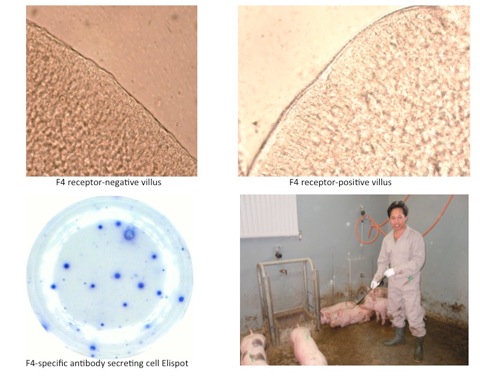
Publications
Contact : Ut Nguyen Van
Nguyen.VanUt@ugent.be
Using Lactococcus lactis to target the intestinal immune system.
PhD Bakr Ahmed, Promotor Prof. Eric Cox
Lactococcus lactis offers a promising tool for delivery of mucosal vaccines.
The organism has a well-established history of safe use in food industry and is highly amenable to genetic modification.
Regarding to our interest in mucosal protection against Enterohemorrhagic Escherichia coli (EHEC), L. lactis is genetically modified for recombinant expression of EHEC vaccine candidates. The recombinant strains are being evaluated for their ability to induce mucosal and systemic protective immune responses in BALB/c mice upon oral administration.
Contact : Bakr Ahmed
Bakr.Ahmed@ugent.be
4/ Prophylaxis of infections with enterotoxigenic and verotoxigenic E. coli in the pig.
Towards selection on F4 and F18 ETEC resistance in pigs for prevention of post-weaning diarrhoea.
IWT-LO Grant, 2010-2014, Ut Nguyen Van and Tiphanie Goetstouwers, Promotor Prof. Eric Cox, Co-Promotors Prof. Luc Peelman and Prof. Dieter Deforce
Introduction:
Enterotoxigenic Escherichia coli (ETEC) is an important cause of neonatal and post-weaning diarrhoea in piglets. This disease results in economical losses in pig husbandry due to mortality, growth retardation, and medication. ETEC involved in post-weaning diarrhoea mainly express F4 or F18 fimbriae. There are 3 serotypes of F4 fimbriae, namely F4ab, F4ac and F4ad, which are characterized by differences in receptor binding sites. F4 or F18 fimbriae are responsible for binding of the bacteria to specific receptors on small intestinal enterocytes, resulting in colonization of the small intestine. The presence or absence of these receptors is based on genetic inheritance in which F4R or F18R expression is the dominant character. Since the Fimbriae-mediated adhesion is a prerequisite for infection, piglets without F4R/F18R are resistant to F4+/F18+ ETEC infections.
A mutation in the MUC4 gene would be responsible for the difference between F4ab/ac receptor-positive and receptor-negative pigs. However, a study that was done in our lab showed that not all resistant MUC4 pigs in this test are real receptor negative pigs. Probably, there are more F4R genes beside MUC4. Related to F18 susceptibility, FUT1 gene was shown high correlation. F18 resistant pigs have a point mutation in this gene. Blood group receptor sugars were found as F18R. However, which enzyme, FUT1 or FUT2 are involved in synthesis of the F18R have not been clarified.
Aims
The aim of this project is to develop a diagnostic DNA test for routine selection F4ab/acR-, and F18R- pigs.
The 2 main objectives of this project are:
- To identify genes which encode for receptor glycoproteins or sugars that bind F4 fimbriae.
- To identify the relation between FUT1 and F18 blood group receptor sugars.
Based on causal mutations correlated to F4 ETEC susceptibility, in combination with F18R gene, a diagnostic DNA test for F4R-, F18R- pigs will be developed. This test will be applied to select F4R-, F18R- pigs for breeding program to increase the value of pigs.
There are cooperation with the laboratory of Animal Genetics (Faculty of Veterinary Medicine) and the laboratory of Pharmaceutical Biotechnology (Faculty of Pharmaceutical Science) in this project.

Publications
Contact : Ut Nguyen Van
Nguyen.VanUt@ugent.be
Evaluation of seed produced anti-F4+ETEC antibodies in prevention of enterotoxigenic Escherichia coli caused post-weaning diarrhoea in piglets, a proof of concept.
IOF StarTT, 2012-2013, Dr. Vikram Virdi, Promotor Prof. Eric Cox, Co-Promotor Prof. Depicker An and Dr. Sven Arnouts
Cooperation with Prof. Depicker An, Department of Plant Systems Biology, VIB
The main objective of this project is to evaluate if passive immunization by feeding seeds containing anti-ETEC antibodies can prevent diarrhoea in recently weaned piglets, thereby providing a proof-of-concept in vivo and enabling further valorisation of the technology and of the resultant product.
In the department of Plant Biotechnology and Bioinformatics, under the supervision of Prof. Depicker, a technology and knowhow was developed to produce antibodies in seeds. The goal of the ongoing project is to produce disease specific antibodies in plant seeds and by incorporating those in feed, obtain passive immunization and prevent PWD in a cost effective manner. To demonstrate proof of concept, one of the predominant ETEC strains carrying F4 fimbriae (F4+ETEC) were used to isolate 4 specific antibody encoding genes. Upon transformation in Arabidopsis, the corresponding anti-F4+ETEC antibodies accumulate to 1-3% of seed weight, and more than a kg of seeds with antibodies were obtained, enough to mix in 50 kg starters feed.
The next step is to obtain proof of concept of passive immunisation by oral feeding of antibodies.
The best way to evaluate whether the seed produced anti-F4+ETEC antibodies will prevent PWD is to perform a challenge experiment, and this is the experiment proposed in this StarTT project.
The animal trial will be carried out in Prof. Cox’s lab as he is an expert in this pathology. In parallel, the antibody constructs are being transformed into soybean, and the quality and quantity of the antibodies will be evaluated to develop a prototype of marketable feed.
Publications
Contact : Vikram Virdi
vivir@psb.vib-ugent.be
5/ Action mechanisms of glucans in the pig, dog and horse.
Selective targeting of epithelial receptors to modify the dialogue between enterocytes and antigen presenting cells from tolerogenic to immunogenic
PD UGent BOF Grant, 2013-2015, Dr. Bert Devriendt, promotor Eric Cox
The gastro-intestinal lymphoid tissue constitutes the largest immune system in the mammalian body and is the primary route by which the body is exposed to foreign antigens. As such the default response mode of the intestinal immune system to soluble antigens is immunological hyporesponsiveness or oral tolerance. Due to the dominance of these immunosuppressive mechanisms, oral vaccination with soluble antigens is generally ineffective to induce protective immunity, although a few exceptions exist, such as F4 fimbriae purified from enterotoxigenic E. coli. Understanding the mechanisms driving the oral immunogenicity of these rare antigens is pivotal to grasp how intestinal immune responses can be modulated towards tolerance or protective immunity. Our research group previously demonstrated that F4 fimbriae are potent oral immunogens, which can be partly explained by their receptor-mediated transcytosis via enterocytes. Aminopeptidase N (APN) was recently identified as the involved epithelial receptor and we intend to elucidate the function of APN in the intestinal immunogenicity of F4 fimbriae. The current project will deepen our understanding of APN-induced intestinal immunity and will provide insights in how we can modulate the APN-mediated crosstalk between enterocytes and the underlying antigen-presenting cells to obtain the desired immune response in both pig and human, as pigs resemble genetically, physiologically and immunologically human more closely than mice.
immunologically human more closely than mice.
Publications
Contact: Bert Devriendt
B.Devriendt@UGent.be
6/ Improved diagnostics and immunity against infections with enterohemorraghic E. coli in sheep and cattle.
FOD RF 10/6233 EHEC CLEARANCE project, 2011-2015, PhD Evelien Kieckens, PhD Joanna Rybarczyk, Promotor Prof. Eric Cox, Co-Promotor and Prof. Daisy Vanrompay, Co-Promotor Prof. Lieven De Zutter and Prof. Jean-Paul Remon
Summary
Enterohemorrhagic Escherichia coli (EHEC) are a major food-borne pathogen causing severe disease in humans worldwide. The clinical spectrum of E. coli includes bloody or non-bloody diarrhoea, haemorrhagic colitis (HC), haemolytic uremic syndrome (HUS), the leading cause of chronic renal failure, and mortality, mainly in children. Current treatment is largely limited to supportive care, as no specific regimen against an E. coli O157:H7 infection exists and the use of antibiotics is not recommended because they can cause the release of Shiga toxins from the bacterium, so worsening the infection. Ruminants as cattle, sheep and goats are the most important reservoir of EHEC, harbouring the bacteria in the gastrointestinal tract without showing clinical symptoms. Shedding of EHEC from animals is influenced by many factors such as animal age, diet, stress, housing conditions and season. EHEC is transmitted to humans primarily through consumption of contaminated foods, such as raw or undercooked ground-meat products, raw milk, vegetables, contaminated water, direct contact with animals or contact with infected people. Various strategies to reduce intestinal colonisation of cattle by zoonotic STEC have been tried with varying results, including vaccination, treatment with probiotics, administration of bacteriophages, and modification of the diet. These strategies are either too expensive, too labour intensive and only show a limited effect. Therefore, there is need for new intervention strategies and only the continued intense research efforts on EHEC will provide further insights into the commensal versus pathogenic lifestyles of these E. coli and lead to approaches to reduce EHEC carriage of ruminants as well as prevent or treat human disease.
Aims
1. Better understanding the mechanism of colonisation of the ruminant intestinal mucosa by E. coli O157:H7 and the role of the intestinal mucosal immune system.
2. Optimisation of the oral administration of lactoferrin to ruminants via the feed. This includes the development of pellets that can be mixed with the feed.
3. Develop a strategy to prevent EHEC contamination of meat.
The role of the immune system in the persistence of E. coli O157:H7 is poorly understood. Some of the virulence factors of the bacterium may suppress the immune system. Therefore, there is need for an improved knowledge of the immune response that occurs during infection to gain a better insight into the mechanisms behind persistence and clearance of the infection.
For lactoferrin, some important issues have to be clarified. One issue is the administration form. Therefore a formulation has to be developed that can be given together with the feed. Development of novel oral delivery system which allow the selective release of the drug close to its effector side, in a high dispersed way, prevent lactoferrin of being consumed by ruminal bacteria.
Contamination of meat usually occurs during animal slaughter, as a result of poor slaughter practices, abattoir hygiene and animal handling practices . By reducing the faecal pathogen load, the pathogen prevalence and the amount of contamination in hides will be reduced and consequently, carcass contamination rates decrease. Therefore there is a need to find new strategies, which could effectively reduce E. coli O157:H7 infection on the farm level.
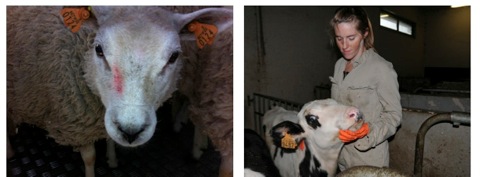
Publications
Contact : Evelien Kieckens and Joanna Rybarczyk
Evelien.Kieckens@ugent.be, Joanna.Rybarczyk@ugent.be
E. coli O157 in the export and local meat chain and its public health importance in Ethiopia
VLIR EI project with the ADDIS ABABA University in Ethiopia, PhD Akafete Teklu, Promotor Prof. Eric Cox, Co-Promotor Prof. Lieven De Zutter
Aims:
This project aims to study the prevalence, distribution and risk of E. coli O157 in the export and local meat value chain in the country, exposure assessment to the public, and how meat producers and retailers can work together to reduce the occurrence of this pathogen and help to promote the food safety requirements.
More specific:
-To provide institutional analysis of the export and domestic meat supply chain to understand the general hygiene of the meat handling facilities in the chain and consumer and how these affect the occurrence of E. coli O157.
-To do detail study on the occurrence, distribution, survival, antimicrobial resistance pattern, virulence factor etc of E. coli O157 on each meat delivery points.
-To do survey for the presence of human outbreaks in the area in question and risk assessment study and its potential implications as health hazard to consumers.
-Locate the major point where safety problem occurs along the meat export chain, assisting abattoirs in safety management system for the implementation of HACCP plan.
-Risk communication of the findings to a variety of stakeholders in order to reducing the risk of E.coliO157.
Contact : Eric Cox
Eric.Cox@ugent.be
7/ Improved diagnostics and immunity against infections with Toxoplasma gondii in pigs and sheep.
Cooperation with Prof. Pierre Dorny, Unit of Veterinary Helminthology, ITG Antwerp;
And with Dr. Katelijne Dierick, WIV-ISP, Communicable and infectious diseases, Foodborne pathogens
Toxoplasma gondii - research
PhD Gosia Jennes, Promotor Prof. Eric Cox
Toxoplasma gondii is an obligate intracellulair parasite which is responsible for a zoonotic disease in humans. It has a complex lifecycle and various intermediate hosts, among which humans. The main infection routes in humans are both the consumption of meat containing tissue cysts and ingestion of oocysts present in the environment. Currently, there is no official screening system for assessing the T.gondii prevalence in domestic animals neither at farm nor at the slaughterhouse level. Therefore we collect the epidemiologic data to determine the seroprevalence of toxoplasmosis in pigs and sheep in Belgium. Additionally, we study the experimental infections with T. gondii in intermediate hosts to reveal the underlying mechanisms of the immune response. This knowledge is necessary for developing an experimental vaccine to prevent the disease in farm animals and, on long term, to decrease the risk of toxoplasmosis in humans.
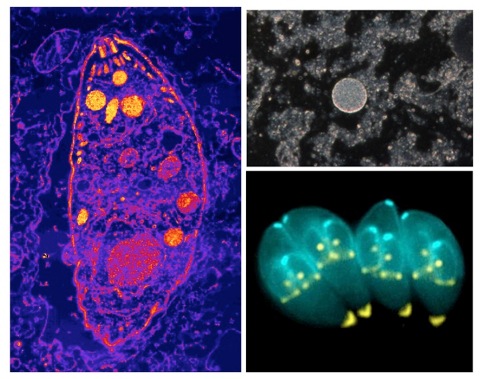
Toxoplasma gondii Cyst
Publications
Contact : Gosia Jennes
Malgorzata.Jennes@ugent.be
Evaluation of a vaccine against congenital Toxoplasmosis.
IWT SBO PhD Grant, 2009-2013, Delfien Verhelst, Promotor Eric Cox
Toxoplasma gondii is an intracellular parasite, responsable for a worldwide zoonosis. Although the disease is usually asymptomatic, it can still cause severe pathology in both humans and animals. The clinical effects are usually associated with huge economic costs, again in human and veterinary field. The greatest risk factor for human consumption still remains raw or undercooked infected meat, which can lead to congenital toxoplasmosis. Toxoplasmosis in livestock farming creates an economic loss, mainly due to production losses in sheep. The symptoms of congenital toxoplasmosis in sheep varies from early embryonic death, to spontaneous abortion, mummified lambs and the birth of weak lambs. The economic impact due to loss of lambs is estimated at £ 12 million per year for Great Britain (1), and NZ $ 14 million per year for New Zealand (2). In contrast to other parasite such as Taenia saginata and Trichinella spiralis, screening method for Toxoplasma gondii doesn’t exist. There isn’t a detection method on the level of the slaughterhouse to prevent tissue cysts entering the food chain. So there are other preventive measures necessary to avoid the oral transmission of this zoonotic disease to humans (3). There is an attenuated vaccine available for use in sheep (Toxovax ®, Intervet) that sheep protect against spontaneous abortion during pregnancy, but it doesn’t provide sterile immunity for fetus and mother (4, 5). Because this vaccine consists of live attenuated tachyzoites, serology can not distinguish between infected and vaccinated ewes. Furthermore, this vaccine also possesses other disadvantages such as the production of live tachyzoites, the risk of reversion to the wild type, cold chain and the contamination risk to the attending veterinarian.
Congenital toxoplasmosis in sheep is due to oral infection with T. gondii oocysts. The time between the intake of oocysts and the infection is so short, only a few days, we wonder whether the adaptive mucosal immune response may play a role in preventing the infection with T. gondii.
To investigate if the intestinal barrier or systemic immunity plays a role during infection, we have to evaluate the infection kinetics in vivo. To investigate the role of the intestinal barrier we have to immunise, serological toxoplasma negative, lambs of 3 months old orally with 3000 cysts of the Prugniaud strain. On day 2, 4, 6, 8, 10 and 14 after infection the parasitic load in the lamina propria, epitheelcellen, Peyers Patches and mesenteriale lymphnodes of immune and seronegative sheep has to be analysed with quantitative real-time PCR (qPCR). The cytokines in the Peyers Patches en mesenterial lymphnodes has to be analysed with qPCR; and after antigen restimulation with cytokine ELISA.
Afterwards we’ll investigate the role of the systemic immunity, instead of infecting the sheep orally, we’ll infect them intramuscular in the hindquartes with tissue cysts. Again on day 2, 4, 6, 8, 10 and 14 after infection the draining lymph nodes of the immune and seronegative sheep will be removed and checked for cytokines and parastic load with qPCR and after restimulation with cytokine ELSIA.
With this research we can investigate if the intestinal barrier plays a role during a Toxoplasma gondii infection. If it is, the parasitic load in the intestines and adjoining tissues will be less in immune than in seronegative animals. On the other hand we can also assess how the systemic immunity will play a role in the protection.
Publications
Contact : Delfien Verhelst
Delfien.Verhelst@ugent.be
Evaluation of a vaccine against congenital Toxoplasmosis in sheep, Investigation of the role of the intestinal barrier during a Toxoplasma gondii infection
Welcome Erasmus grant project, 2013, Dr. Yara Al Kappany, Promotor Prof. Eric Cox
Idem above
Toxoplasma gondii: Serological and Molecular Epidemiology in Sheep, Goats and Women of the Central Ethiopia
VLIR EI project with the ADDIS ABABA University in Ethiopia, PhD Endrias Zewdu Gebremedhin, Promotor Prof. Pierre Dorny, Co-Promotor Prof. Eric Cox
The study will identify the genotypes of the parasite present in animals and human population of the country, and also delineates the transmission pathway of the parasite among animals and humans. Specifically, the importance of animal originated genotypes in infecting the human population will be addressed using molecular characterization of the isolates. Furthermore, possible sources of human and animal infection may also be suggested. Therefore, it is anticipated that the study will generate base-line data for further studies leading to designing cost-effective prevention and control of the disease both at regional and national levels. The genetic natures of Toxoplasma gondii strains circulating in Ethiopia will be identified for the first time.
Publications
Contact : Pierre Dorny
pdorny@itg.be
8/ Immunity and vaccination against Chlamydia trachomatis infections in a pig model and Chlamydia suis infections in the pig.
Cooperation with Prof. Daisy Vanrompay, Laboratory of Molecular Biotechnology of the Faculty of Bioscience Engineering UGent
Development of diagnostics and innovative therapeutics for Chlamydiaceae infections in the Belgian pig sector. (Chlamysuis)
FOD RF 10/6234 CHLAMYSUIS project, 2011-2015, PhD Kristien De Puysseleyr and Leentje De Puysseleyr, Promotor Prof. Daisy Vanrompay, Co-Promotor Prof. Eric Cox, D. Deforce, W. Van Criekinge, Dr. Sven Arnouts
Introduction
Cp. Abortus and mainly C. suis are currently strongly spread in the German, Swiss and Italian pig population. In 1998 the first tertracycline resistant (tetR) C. suis strains were isolated in the American pig companies and between 2004-2007 in the Italian pig companies
A few months ago the first tetR C. suis strains were isolated in Belgium which involved fertility problems in sows and boars (unpublished results). Moreover the tetR is horizontally transferrable between C. suis and the phylogenetically strongly related human pathogen C. trachomatis. This is a potential risk for public health.
Aim
a/ Development and validation of an affordable and easy performable serological screening method for detection of C. suis and Cp. abortus specific antibodies in pigs.
b/ Implementation of :
-Recently developed Chlamydiaceae species-specific molecular diagnostic tests (real-time PCR, micro-array, and PCR for the detection of tetR C. suis strains)
-The serological tests in this project will be developed for the evaluation of the economical impact of C. suis and Cp. abortus in the Belgian pig sector.
c/ Research of the transfer of tetR C. suis en Cp. abortus strains from livestock to the personnel of the slaughterhouses.
d/ Creation of a scientific database for the development of innovative therapeutics like ‘virulence blockers’ as alternative for antibiotics and recombinant vaccines.
Publications
Contact : Kristien De Puysseleyr and Leentje De Puysseleyr
Kristien.DePuysseleyr@ugent.be, Leentje.DePuysseleyr@ugent.be
9/ Cytokine response in dogs and horses.
No current projects
10/ Food allergy in dogs
FWO SB PhD Grant 2015-2019 - PhD Michael Pelst - Promotor Prof. Eric Cox
The prevalence of allergic diseases is high, this is not only the case in human medicine, dogs are also frequently presented to the veterinarian with an allergic disease. Approximately 8-10% of dogs suffer from environmental allergies and approximately 1% of dogs develops food allergy. In human medicine, intradermal tests and quantification of allergen-specific serum immunoglobulin E (IgE) can be a helpful tool to identify the allergens causing food allergy. Unfortunately, these tests are known to be unreliable in dogs. For the moment, the diagnosis of allergic diseases in this species relies on a time-consuming elimination process of other causes of itch or gastro-intestinal complaints. Dogs with food allergy frequently show itch and to a lesser extent gastro-intestinal symptoms. Because food allergy induces the same skin symptoms as environmental allergy, it is difficult to differentiate both diseases based on the clinical presentation. For the moment, the only way to diagnose both allergic diseases is to feed the allergic dog a strict hypoallergenic diet for a minimum of two months to see whether the clinical symptoms abate. A hypoallergenic diet is a diet that contains either hydrolysed proteins or a novel protein source for the dog. Such diets aren’t cheap and it is important that the owner continuously watches its dog to ensure that the animal only eats the hypoallergenic diet during the two months. After all, ingestion of other food components can lead to a false diagnosis. In summary, diagnosing food allergy or environmental allergy in dogs is a difficult time- and money-consuming process.
There are several indications that identifying lymphocyte homing-receptors can contribute to the development of quick methods to diagnose allergies in dogs. Studies in this species have shown that the lymphocyte response (cellular immunity) is more strongly correlated with the causative food allergen than the concentrations of allergen-specific IgE in serum or the results of intradermal tests (humoral immunity). Homing-receptors direct the migration of lymphocytes from the blood stream to specific tissues such as the skin and gastro-intestinal system. It has been shown in multiple independent studies that allergen-specific cells from humans with allergy express specific subsets of such homing receptors. Also in dogs, a correlation has been found between expression of the skin-homing CCR4-receptor and the occurrence of environmental allergy. The role of other homing-receptors in the pathogenesis of canine allergies remains to be elucidated. Therefore, during this project, the expression of several homing-receptors in dogs with allergies will be investigated and their potential to aid in the diagnosis of canine allergic disease will be evaluated.
Immune mechanisms in canine food allergy BOF PhD Grant 2012-2016 - PhD Elisa Maina - Promotor Prof. Eric Cox
Introduction Food allergy is an adverse health effect arising from a specific immune response that occurs reproducibly on exposure to a given food and that differs from food intolerance, which is not immune-mediated. In humans different types of food allergy have been described: IgE mediated, non-IgE mediated and mixed IgE and non-IgE mediated. IgE mediated reactions are type I hypersensitivity reactions that are characterized by immediate and intermediate hypersensitivity to food causing a reaction within minutes to, more rarely, hours. Non-IgE mediated food allergies can be either type II, III and/or IV (=delayed) hypersensitivities with symptoms appearing hours (type I and II) to days (type IV) after food intake. Although handbooks present IgE mediated food allergy in dogs as the most general occurring mechanism, this is still being questioned by several studies and observations. Indeed in some studies it has not been possible to demonstrate food antigen-specific IgE antibodies in dogs with proven food allergy, in addition, available tests for hypersensitivity type I diagnosis are not reliable in dogs. The only really effective tool for food allergy diagnosing in dogs is deprival of food allergens for at least 6 to 8 weeks. This deprival does not result in a significant decrease in allergen-specific IgE. Dermatologic and gastrointestinal signs appear rarely minutes, mostly days (± 80 %) after ingestion of the allergen. All of these problems could be explained by a different underlying immune mechanism.
Aims The hypothesis of this PhD research is that delayed type hypersensitivity is the major mechanism responsible for food allergy in an important number of dogs. Therefore :
-Healthy dogs and dogs in which the food allergy suggests a delayed type of hypersensitivity will be selected. -Proliferation of lymphocytes against food allergens will be further optimized. -Lymphocytes responsible for proliferation will be further phenotyped based on expression of CD antigens and cytokine production. -In vitro the effect of stimulation of these lymphocytes with allergens will be determined on monocytes and mast cells. -A test will be developed for diagnosing this type of food hypersensitivity and this test will be evaluated in clinical settings.
 Contact : Elisa Maina
Elisa.Maina@ugent.be
Contact : Elisa Maina
Elisa.Maina@ugent.bePublications
Maina, E., & Cox, E. (2016). A double blind, randomized, placebo controlled trial of the efficacy, quality of life and safety of food allergen‐specific sublingual immunotherapy in client owned dogs with adverse food reactions: a small pilot study. Veterinary dermatology, 27(5), 361.
Maina, E., Pelst, M., Hesta, M., & Cox, E. (2017). Food-specific sublingual immunotherapy is well tolerated and safe in healthy dogs: a blind, randomized, placebo-controlled study. BMC veterinary research, 13(1), 25.
Maina, E., Devriendt, B., & Cox, E. (2017). Changes in cytokine profiles following treatment with food allergen‐specific sublingual immunotherapy in dogs with adverse food reactions. Veterinary Dermatology.
Conference presentations and posters
Maina, E., & Cox, E. (2016). A double blinded, randomized, placebo-controlled trial of the efficacy, quality of life, tolerability and safety of food allergy-specific sublingual immunotherapy in client-owned dogs with food allergy: results of a small pilot study. Conference: 8th World Congress of Veterinary Dermatology
Maina, E., & Cox, E. (2016). n-6 polyunsaturated fatty acid (PUFA)-rich oil intake may enhance the susceptibility to develop adverse food reactions in dogs. Conference: 7th international conference on Allergy, Asthma and Clinical Immunology.
11/ Interactions of alphaherpesviruses with the immune system
Herpesviruses are large DNA viruses with an envelope. The Alphaherpesvirus subfamily of the herpesviruses comprises closely related members of man and animal, including herpes simplex virus (HSV)(cold sores, genital ulcerae) and varicella-zoster virus (chickenpox, shingles) in man, pseudorabies virus (PRV) in pigs and equine herpesvirus 1 in horses (both nervous disorders, respiratory problems, abortion), bovine herpesvirus 1 in cattle (IBR, respiratory problems, abortion), etc... A hallmark of these viruses is that an interplay between virus, host cell and the immune system leads to the establishment of lifelong latent (dormant) infections. For viruses like HSV and PRV, trigeminal ganglion neurons represent central sites of viral latency. Specific circumstances, often stress-related, may lead to recurrent virus reactivation and disease (e.g. cold sores with HSV).
We use the porcine pseudorabies virus (PRV) as a model system for alphaherpesviruses in general and study several virus-cell interactions, with emphasis on virus-cell interactions that allow the virus to delay or limit recognition and destruction by the immune system. Besides a couple of other research topics, we are studying the following:
1. PRV interactions with the cellular cytoskeleton.
This research topic mainly focusses on the US3 protein kinase of PRV, a viral kinase conserved among alphaherpesviruses. We have found that this US3 protein leads to substantial rearrangements in the host cell cytoskeleton, leading to loss of actin stress fibers, cell retraction and formation of cell extensions (Van Minnebruggen et al., 2003, J Virol, Favoreel et al., 2005, PNAS). Virus particles were found to move in the cell extensions, towards the tip and to neighbouring cells, even in the presence of virus-neutralizing antibodies (Favoreel et al., 2005, PNAS). We are currently trying to elucidate the molecular mechanism of the US3-induced cytoskeleton rearrangements. We have identified p21-activated kinases and cofilin as central players in these US3-induced actin rearrangements (Van den Broeke et al., 2009, PNAS, Jacob et al., 2013, J Virol).
Researchers: Céline Van den Broeke, Thary Jacob
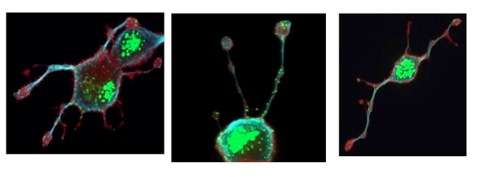
2. PRV interactions with components of the innate immunity.
We investigate the interactions of PRV with several components of the innate immunity. We have focused particularly on type I interferon. In trigeminal ganglion neurons, the major site of latency for PRV and HSV, we have shown that addition of type I interferon leads to the establishment of a latent infection of PRV and HSV in these cells (De Regge et al., 2010, PLoS One). We have also identified the PRV IE180 protein as a novel immune evasive protein as it interferes with the ability of interferon to lead to phosphorylation and thereby inactivation of the translation initiation factor eIF2alpha (Van Opdenbosch et al., 2012, J Virol). We are also investigating the interaction of PRV with immune cells that are critical in the innate immune response, including plasmacytoid DC and NK cells.
Researchers: Korneel Grauwet, Jochen Lamote
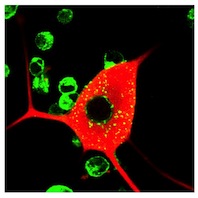
3. PRV interactions with signaling in immune cells.
We have shown before that the gE protein of PRV can induce intracellular signaling that resembles immune receptor signaling (Desplanques et al., 2007, Virology). We are currently investigating the effect of gE on signaling in and biological activity of T lymphocytes.
Researchers: Maria Pontes

Publications
Contact : Herman Favoreel and Céline Van den Broeke
Herman.Favoreel@ugent.be, Celine.VandenBroeke@ugent.be
12/ Vaccination of dolphins against Erysipelothrix rhusiopathiae
PhD G. Lacave, Promotor prof. Eric Cox
Active and passive immunity in dolphins in order to develop an effective vaccination against Erysipelothrix rhusiopathiae (in cooperation with the dolphinaria of Brugge and Antwerp).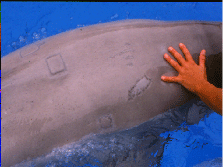
Erysipelas rhomboid lesions on a dolphin skin
Publications
Contact : Eric Cox
Eric.Cox@ugent.be






